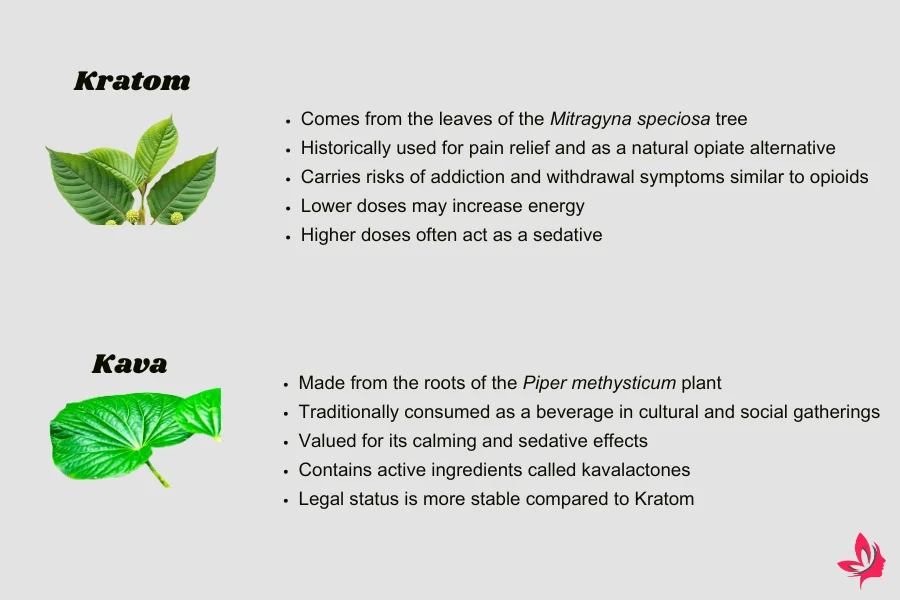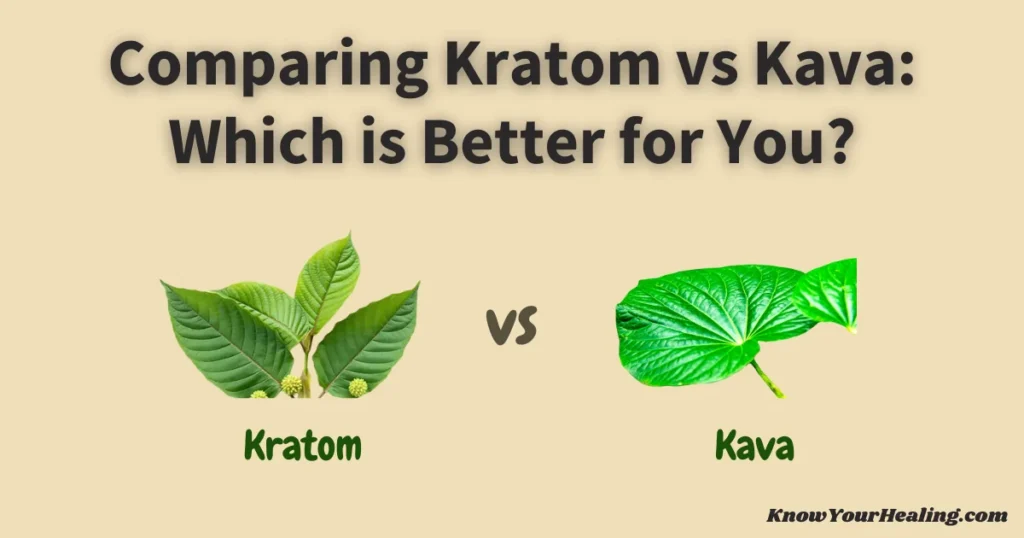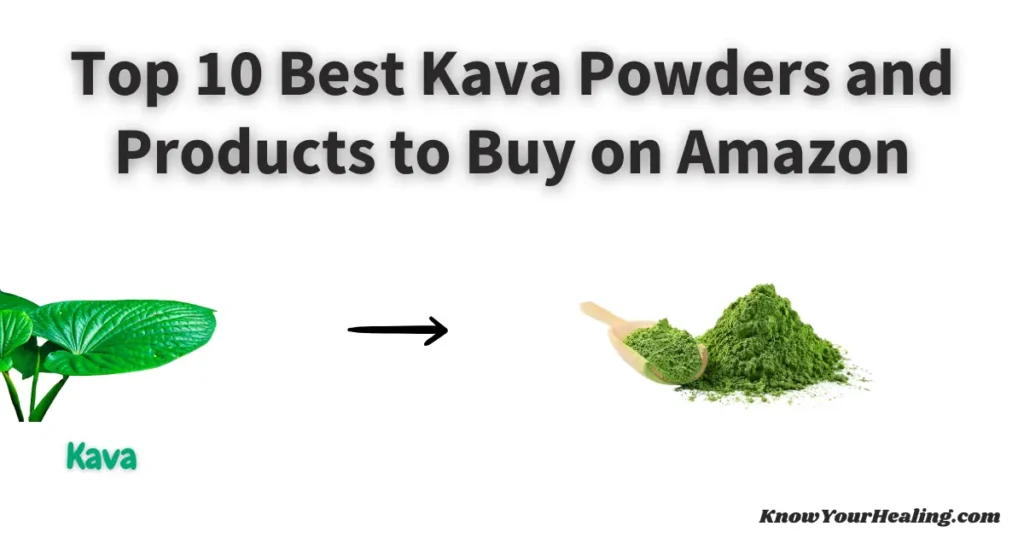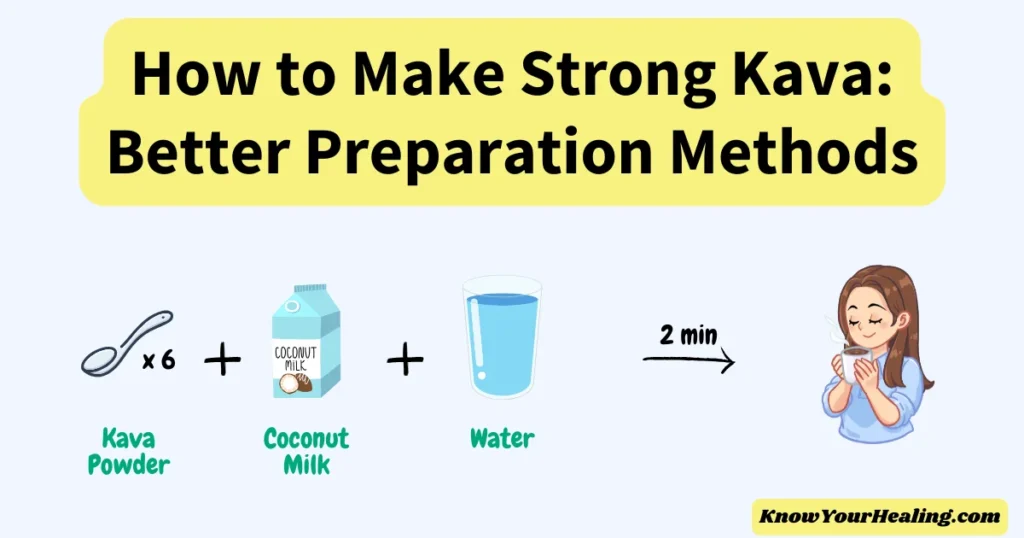Kratom vs Kava: If you’re curious whether kratom or kava is the better choice for your needs, you likely want clear and helpful information. These two natural substances have gained popularity for their calming and energizing effects but serve different purposes.
Kratom is generally more suitable for those seeking pain relief and stimulation, while kava is often preferred for anxiety and stress relief.
People may encounter liver concerns when consuming kava excessively, as noted in discussions about kava vs kratom. In contrast, kratom is linked to dependency and other side effects.
Each has unique effects on the brain, with kratom’s alkaloids offering diverse benefits compared to kava’s influence on GABA receptors.
Exploring the differences can help you decide which is best for your lifestyle. Understanding their distinct roles in relaxation and energy will enable informed decisions about which might benefit you.
Introduction to Kratom and Kava

Kratom and Kava are herbal supplements that have gained attention for their unique effects on the body. Both are known for their potential benefits and risks and originate from different parts of the world.
What is Kratom?
Kratom originates from the leaves of the Mitragyna speciosa tree, native to Southeast Asia.
It is known for its stimulant and sedative properties, depending on the dose. Lower doses may increase energy, while higher doses often act as a sedative.
Kratom has been used for centuries for its potential to aid in pain relief and as a natural alternative to opiates. However, kratom use carries potential risks, including addiction and withdrawal symptoms, similar to opioids.
The leaves contain active compounds, such as alkaloids mitragynine, which interact with opioid receptors in the brain.
In recent years, kratom has become more popular as a dietary supplement in countries like the United States. Despite its use, the legal status of kratom is complex.
Some regions, like Rhode Island and Sarasota County, have banned it due to safety concerns. Therefore, individuals should exercise caution and consult healthcare professionals when considering kratom products.
What is Kava?
Kava is made from the roots of the Piper methysticum plant, found in the South Pacific islands. It is traditionally consumed as a beverage, particularly in cultural and social gatherings.
Kava has been valued for its calming and sedative effects, making it a popular choice for managing anxiety disorders and stress. The roots contain active ingredients called kavalactones, which affect the limbic system and produce a sense of relaxation and mental clarity.
Kava bars have emerged in the Western world, highlighting its cultural significance. Kava’s legal status is more stable compared to kratom, but it also presents risks, such as potential liver damage when consumed in high doses.
Understanding the different effects and safety concerns associated with kava is essential for making informed decisions about its use.
Effects and Benefits of Kratom vs Kava
Kratom and kava are popular choices for those seeking natural remedies. They are derived from plants native to different parts of the world.
Their effects vary significantly, with kratom being especially noted for pain relief, while kava is more often used for relaxation.
Pain Relief and Sedative Effects
Comparison of Kratom and Kava: Effects, Uses, and Risks
| Substance | Primary Effects | Uses | Mechanism | Risks |
|---|---|---|---|---|
| Kratom | Pain relief, euphoria at lower doses | Managing chronic pain, aiding withdrawal symptoms | Acts on opioid receptors | Potential for addiction, sedation at high doses |
| Kava | Sedative effects, calming | Relieving anxiety and stress in social settings | Derived from the roots of the kava plant | Minimal cognitive impact, lower risk of addiction |
Active Compounds and Mechanisms
The active compounds in kratom include alkaloids like mitragynine and 7-hydroxymitragynine. These interact with the user’s limbic system and opioid receptors, leading to its unique effects.
These compounds make kratom particularly effective for pain relief but also contribute to its potential risks.
In contrast, kava derives its effects from kavalactones found in the root of the kava plant. These do not interact with opioid receptors; instead, they work to enhance relaxation and reduce stress.
Kava usage poses fewer risks of dependency or adverse withdrawal symptoms, making it a safer choice for those concerned with safety and health.
Safety and Risks Associated with Use
Kratom and kava, both used for their calming effects, carry distinct safety concerns and risks. While kratom is popular for pain relief and its interaction with opioid receptors, kava has been linked to potential liver damage, particularly in high doses.
Potential Side Effects and Risks of Kratom
Kratom is derived from the leaves of the mitragyna speciosa tree, native to Southeast Asia. It is known for its stimulating effects and potential pain relief.
Kratom use can result in dependency, with withdrawal symptoms similar to opioids.
High doses may lead to various side effects, including nausea, vomiting, and dizziness. Significant concerns exist regarding its impact on the limbic system, which could lead to addictive behavior.
The legality of kratom varies across the United States, with places like Rhode Island banning kratom products due to such risks. These factors make it important for users to be cautious and informed about kratom powder and various forms available as a dietary supplement.
Kava’s Safety Profile
Kava, made from the roots of the piper methysticum plant, has a long history as a traditional beverage in the South Pacific Islands. Its sedative effects make it popular in kava bars and social gatherings.
However, its safety concerns primarily revolve around the risk of liver damage, especially among those consuming kava root in higher doses.
Unlike kratom, kava does not interact with opioid receptors, resulting in a different safety profile.
Kava’s active compounds, kavalactones, can cause mild to moderate side effects like headaches and dizziness. Though kava is generally regarded as a natural alternative to more potent sedatives, users should remain mindful of its potential risks.
Legal Status and Regulation
Kratom and kava differ significantly in terms of their legal status. These differences impact their availability and use in various parts of the world, including the United States, and regions where they are traditionally used, such as Southeast Asia and the South Pacific Islands.
The Legality of Kratom
Kratom’s legal status is complex and varies widely between countries and even within regions of the same country.
Here’s a table summarizing the legal status of kratom in various states across the United States:
| State | Legal Status | Notes |
|---|---|---|
| Alabama | Banned | Kratom is illegal. |
| Arkansas | Banned | Kratom is illegal. |
| California | Legal | Regulated with few restrictions. |
| Florida | Legal | Widely available; some local regulations may apply. |
| Indiana | Banned | Kratom is illegal. |
| Iowa | Legal | No specific regulations. |
| Kentucky | Legal | No specific regulations. |
| Louisiana | Legal | No specific regulations. |
| Maryland | Legal | No specific regulations. |
| Massachusetts | Legal | No specific regulations. |
| Michigan | Legal | No specific regulations. |
| Mississippi | Legal | No specific regulations. |
| Missouri | Legal | No specific regulations. |
| Nebraska | Legal | No specific regulations. |
| New Jersey | Legal | No specific regulations. |
| New York | Legal | No specific regulations. |
| North Carolina | Legal | No specific regulations. |
| Ohio | Legal | No specific regulations. |
| Oklahoma | Legal | No specific regulations. |
| Oregon | Legal | No specific regulations. |
| Pennsylvania | Legal | No specific regulations. |
| Rhode Island | Banned | Kratom is illegal. |
| South Carolina | Legal | No specific regulations. |
| South Dakota | Legal | No specific regulations. |
| Tennessee | Legal | No specific regulations. |
| Texas | Legal | No specific regulations. |
| Vermont | Banned | Kratom is illegal. |
| Virginia | Legal | No specific regulations. |
| Washington | Legal | No specific regulations. |
| Wisconsin | Banned | Kratom is illegal. |
| Wyoming | Legal | No specific regulations. |
Notes: The legal status of kratom can change, and local regulations may vary. It is always advisable to check the latest state laws for the most accurate information.
Federally, the U.S. Food and Drug Administration (FDA) does not regulate kratom, but it has expressed concerns over its safety. This has led to ongoing debates about its classification as a drug of concern.
In places like Southeast Asia, where the leaves of the Mitragyna speciosa tree grow, kratom is often banned or heavily regulated due to its potential risks and opioid-like effects.
Kava Legislation
In contrast, kava enjoys broader acceptance and legality, particularly in the United States, where it is legal in all states.
Kava is often consumed in kava bars as a traditional beverage, and its roots in the Piper methysticum plant are not subject to many restrictions.
This widespread acceptance can be attributed to its historical use in the South Pacific Islands and its association with low sedative effects.
While kava is not heavily regulated, consumers should still be aware of potential risks, such as liver damage from overconsumption.
Making an Informed Decision: Kratom vs Kava
Choosing between kratom and kava involves understanding their distinct properties and determining their potential fit for individual needs.
Both substances have unique benefits and risks, influenced by dosage, intended effects, and environmental setting.
Considerations for Use in Social Settings
Kava is a popular choice for social gatherings, especially in kava bars across the United States. With its roots traced back to the South Pacific Islands, kava is favored for its calming and euphoric effects, making it ideal for relaxing with groups of friends.
Traditionally consumed as a beverage, kava’s calming qualities without strong intoxication make it suitable for maintaining social interactions.
Conversely, kratom, derived from the leaves of the Mitragyna speciosa tree native to Southeast Asia, offers different effects.
In lower doses, kratom can enhance energy and improve mood, which might appeal to those looking for mild stimulation in social settings. Its inclusion in social gatherings is less common due to potential side effects like nausea and unpredictability in its effects.
Finding Natural Remedies
Both kratom and kava are sought after as natural remedies.
Kratom products often target individuals seeking pain relief or support for opioid withdrawal symptoms. Its active compounds, particularly alkaloids mitragynine, offer mild to strong effects based on dosage.
However, considering the risk of addiction and its interactions with opioid receptors, consulting a healthcare professional is recommended.
Kava, derived from the root of the kava plant, is increasingly used for stress and anxiety disorders. Its sedative properties make it appealing as a natural alternative to over-the-counter anxiolytics.
Despite its benefits, there are safety concerns, such as potential liver damage with long-term use of kava, making moderation and medical guidance essential.
Final Thoughts
Kratom offers stimulating effects and is often used for energy and pain relief. However, it has a potential for dependence, especially with regular use.
Kava, on the other hand, is known for its calming effects. It is primarily used to alleviate anxiety and stress. However, high doses may lead to liver toxicity.
Key Takeaways:
- Purpose: Kratom for pain relief, kava for stress relief.
- Risks: Kratom can lead to dependence. Kava can affect liver health.
- Effects: Kratom is stimulating. Kava is calming.
Understanding the characteristics of kratom vs kava helps in determining the right choice for individual needs.
Frequently Asked Questions
Kava and kratom are often discussed due to their uses for relaxation and health benefits. Here are answers to some common questions about these plants, focusing on their effects, legality, and health impacts.
Are kava and kratom the same thing?
Kava and kratom are different plants with distinct uses. Kava is typically used to reduce anxiety and promote relaxation, while kratom is often consumed for its stimulant effects or to alleviate pain. Both can be used recreationally, but they work differently in the body.
Does kava get you stoned?
No, kava does not make people feel “stoned” in the way that cannabis might. It primarily has calming effects, helping to relieve stress and anxiety. Users may experience a sense of relaxation without intoxication.
What drug is kava similar to?
Kava is often compared to anti-anxiety medications due to its calming effects. It may produce feelings similar to mild sedatives, reducing stress and promoting sleep. It is, however, a natural herb and not a synthetic drug.
Is kava an upper or downer?
Kava is considered a downer because it has sedative effects. It helps to calm the mind and body, making it a popular choice for those seeking relaxation or stress relief. Unlike kratom, which can have both stimulating and sedative effects, kava is primarily relaxing.
Is kava or kratom better for anxiety?
Kava is generally more favored for anxiety relief due to its calming properties. Kratom can sometimes cause stimulation, which might not be ideal for anxiety sufferers. Each person’s response can vary, so careful consideration is needed.
How long does kratom high last?
The effects of kratom can vary based on the dose and individual. Generally, a kratom high can last anywhere from 2 to 5 hours. Users typically start feeling the effects within 15 to 30 minutes of consumption.
Is kava hard on the liver?
Yes, kava has been associated with liver toxicity, mainly when consumed in high doses or for extended periods. Some studies have linked kava use to liver damage, so it’s important to use it cautiously and monitor liver health. It’s advisable to consult a healthcare professional before using it regularly.
What form of kava is strongest?
Generally, traditional kava brews made from fresh or dried roots are more potent than commercial preparations or capsules. The potency can also depend on the kava variety and preparation method. Those seeking the most powerful effects often prefer fresh root.
Does kava hit opiate receptors?
No, kava does not directly target opiate receptors. Its effects are primarily due to kavalactones, which interact with the brain but not like opiates. Kava’s calming effect is more aligned with that of sedatives, without the addictive potential of opiates.
Is kava root powder illegal?
Kava root powder is legal in many places. However, some countries have restrictions due to health concerns. So, make sure to check local laws before purchasing or using kava.
Regulations can vary, so it’s important to check local laws before purchasing or using kava. It remains a legal herbal supplement in several regions.




